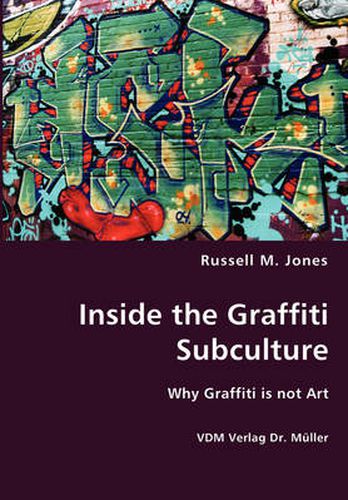Readings Newsletter
Become a Readings Member to make your shopping experience even easier.
Sign in or sign up for free!
You’re not far away from qualifying for FREE standard shipping within Australia
You’ve qualified for FREE standard shipping within Australia
The cart is loading…






This title is printed to order. This book may have been self-published. If so, we cannot guarantee the quality of the content. In the main most books will have gone through the editing process however some may not. We therefore suggest that you be aware of this before ordering this book. If in doubt check either the author or publisher’s details as we are unable to accept any returns unless they are faulty. Please contact us if you have any questions.
Illegal graffiti is disconnected from standard modes of visual production in fine art and design. The primary purpose of illegal graffiti for the graffiti writer is not the visual product, but getting up. Getting up involves writing or painting one’s name in as many places as possible for fame. The elements of risk, freedom and ritual unique to illegal graffiti serve to increase camaraderie among graffiti writers even as an individual’s fame in the graffiti subculture increases. When graffiti has moved from illegal locations to the legal arenas of fine art and advertising; risk, ritual and to some extent, camaraderie, has been lost in the translation. Illegal graffiti is often erroneously associated with criminal gangs. Legal modes of production using graffiti-style are problematic in the public eye as a result. I used primary and secondary interviews with graffiti writers in this book. My art historical approach differed from previous writers who have used mainly anthropological and popular culture methods to examine graffiti. This analysis enabled me to demonstrate that illegal graffiti is not art.
$9.00 standard shipping within Australia
FREE standard shipping within Australia for orders over $100.00
Express & International shipping calculated at checkout
This title is printed to order. This book may have been self-published. If so, we cannot guarantee the quality of the content. In the main most books will have gone through the editing process however some may not. We therefore suggest that you be aware of this before ordering this book. If in doubt check either the author or publisher’s details as we are unable to accept any returns unless they are faulty. Please contact us if you have any questions.
Illegal graffiti is disconnected from standard modes of visual production in fine art and design. The primary purpose of illegal graffiti for the graffiti writer is not the visual product, but getting up. Getting up involves writing or painting one’s name in as many places as possible for fame. The elements of risk, freedom and ritual unique to illegal graffiti serve to increase camaraderie among graffiti writers even as an individual’s fame in the graffiti subculture increases. When graffiti has moved from illegal locations to the legal arenas of fine art and advertising; risk, ritual and to some extent, camaraderie, has been lost in the translation. Illegal graffiti is often erroneously associated with criminal gangs. Legal modes of production using graffiti-style are problematic in the public eye as a result. I used primary and secondary interviews with graffiti writers in this book. My art historical approach differed from previous writers who have used mainly anthropological and popular culture methods to examine graffiti. This analysis enabled me to demonstrate that illegal graffiti is not art.